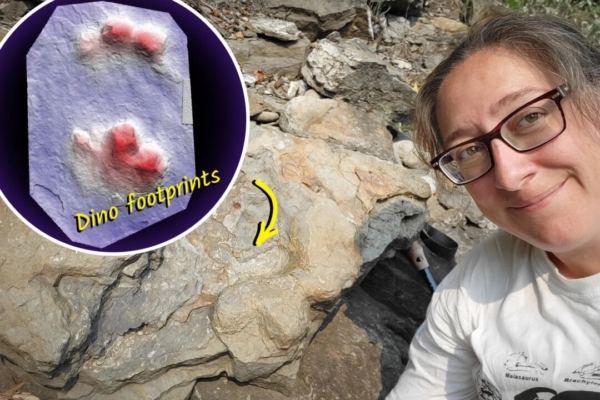In a breakthrough discovery, researchers have unearthed never-before-seen footprints of armored dinosaurs known as nodosaurid ankylosaurs in the Tumbler Ridge region near British Columbia, Canada. These four-legged dinosaurs roamed the earth from the late Jurassic to the late Cretaceous period. However, recent findings have revealed a set of footprints that differ significantly from previously discovered tracks.
This marks the first time such footprints have been identified by the research team.
While nodosaurid ankylosaurs may not be as famous as their relatives with clubbed tails, the ankylosaurid ankylosaurs, who were known for swinging their threatening tails defensively, potentially shattering the shins of numerous tyrannosaurs. Despite scientists knowing that nodosaurid ankylosaurs once inhabited the area, footprints of the ankylosaurid ankylosaurs had never been found there before.
Now, researchers studying these unusual footprints believe they belong to ankylosaurid ankylosaurs.
“Since 2000 when two boys discovered a nodosaurid ankylosaur footprint near Tumbler Ridge, ankylosaurs and Tumbler Ridge have become synonymous,” said Charles Helm, scientific advisor at the Tumbler Ridge Museum, during a press conference.
Ankylosauria is a broader dinosaur family that includes both nodosaurid ankylosaurs and ankylosaurid ankylosaurs.
Over the past few years, footprints of nodosaurid ankylosaurs with four toes have been discovered across North America. In fact, scientists have even named a set of these four-toed footprints from the nodosaurid ankylosaurs as “Tetrapodosaurus borealis.”
Interestingly, Helm had also previously discovered sets of three-toed footprints near Tumbler Ridge. While nodosaurid ankylosaurs have four toes, the ankylosaurid ankylosaurs with clubbed tails only have three toes. These three-toed footprints were later identified and named by the research team as “Ruopodosaurus clava,” found below Tumbler Ridge, honoring the mountainous terrain.
These newly discovered three-toed footprints are estimated to be around 90 to 100 million years old, belonging to the mid-Cretaceous period. This is unusual, as no ankylosaurid ankylosaur skeletal remains have been found in North America from this time period, leading some to speculate they had disappeared from the continent by then.
This speculation has now been proven wrong.
Even more oddly, footprints of ankylosaurid ankylosaurs with clubbed tails have never been found anywhere in the world until now.
“Through this research, we now know that this region was home to two types of ankylosaurid ankylosaurs, and the ‘Ruopodosaurus clava’ footprints are unique to this area in Canada, which is truly exciting,” Helm stated.
Following the discovery of these peculiar three-toed footprints, Helm contacted Victoria Arbour, a curator of paleontology at the Royal BC Museum, inviting her to collaborate with Eamon Drysdale, curator at the Tumbler Ridge Museum, and earth scientist Roy Rule, to identify and interpret these footprints.
It is believed that these massive armored dinosaurs weighed between 2 to 3 tons, with tails resembling giant medieval maces. This explains why their footprints are deeply embedded in the delta lowlands surrounding the Peace River, characterized by shallow lakes and dense vegetation continually shaped by the river’s flow.
“Ankylosaurid ankylosaurs are my favorite group of dinosaurs to study, so discovering new evidence of these dinosaurs in British Columbia is very exciting for me,” Arbour expressed during the press conference. “While we can’t be certain of the specific appearance of the ‘Ruopodosaurus clava’ that left these footprints, we know it was approximately 5 to 6 meters long, had spikes and armor, and had either a bony tail or a complete tail club.”
Researchers excavated stone slabs with raised impressions from multiple small streams, riverbeds, and creeks near Tumbler Ridge, airlifting them via helicopter. These fossil specimens underwent digital processing using photogrammetry to create 3D models for further research. Scientists meticulously measured all details, including the footprint’s length and width, digit length, toe width, stride length, stride width, and stride angle.
“To test the possibility of different ankylosaurid branches as the creators of these footprints, we conducted multiple ancestral state reconstructions of toe numbers,” the research team wrote in a recently peer-reviewed study published in the Journal of Vertebrate Paleontology.
Aside from the distinction between three-toed and four-toed footprints, ‘Tetrapodosaurus borealis’ footprints tend to have longer toes and heels compared to the newly discovered ‘Ruopodosaurus clava’ footprints; furthermore, the physical sizes of the two species differ. The research team compared this finding with fossil records from the Dunvegan and Kaskapau formations in northern Alberta and British Columbia (where numerous ankylosaurid ankylosaur skeletons had been previously found) and noted signs of ankylosaurid ankylosaurs near these new footprint assemblages, confirming the identity of these footprints.
These novel footprints were indeed left by ankylosaurid ankylosaurs.
The enigmatic footprints of these fascinating dinosaurs have finally been uncovered.

